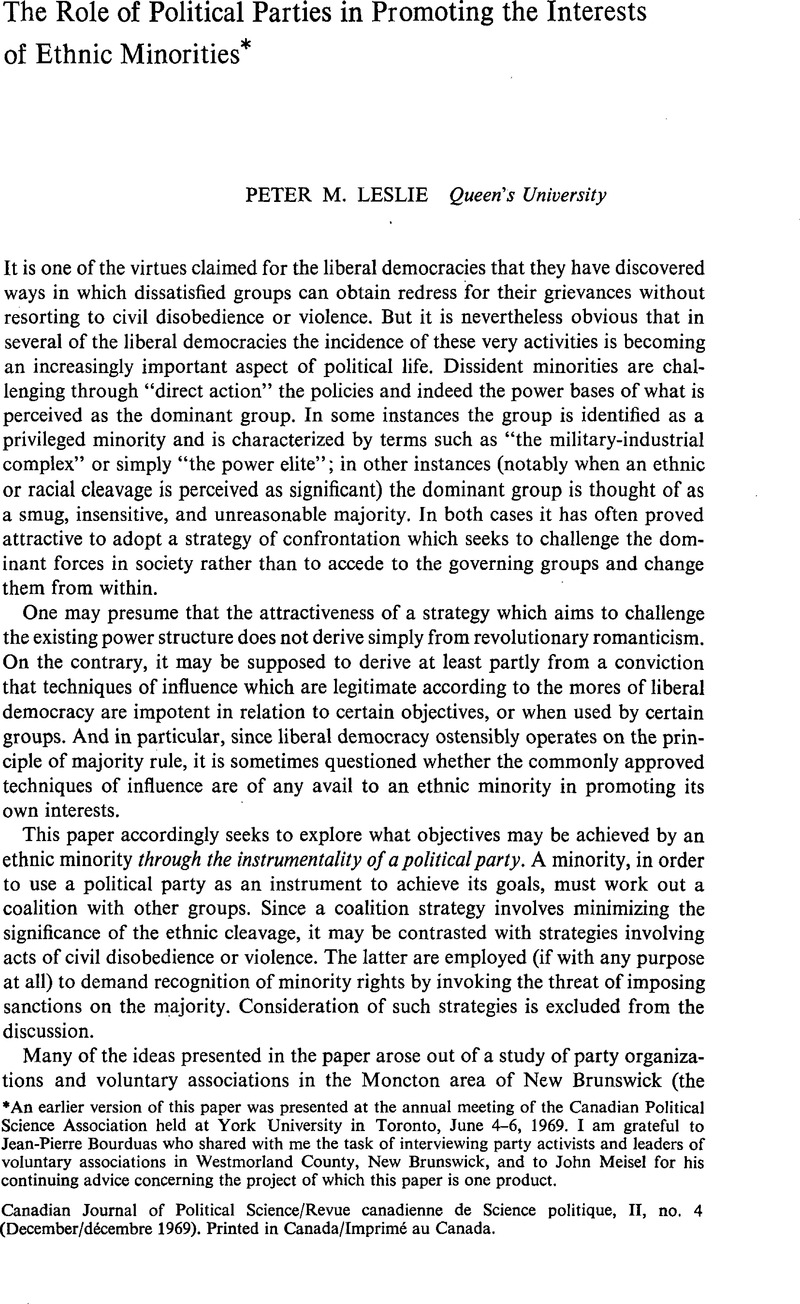Published online by Cambridge University Press: 10 November 2009

1 Interview data suggested several problem-areas and a wealth of hypotheses, some of which are explored in this paper; but the paper makes no pretense to being a report of an opinion survey. The number of respondents—about 50—was too small for this purpose, and interviewees were chosen for their presumed ability to inform us about the activities of their party or other organization(s) rather than in an attempt to constitute a rigorously representative sample. Nevertheless a balance was struck between Liberal and Conservative, Acadian and English-speaking respondents. Interviews were conducted face-to-face on an informal basis, and normally lasted at least an hour—often two or three.
2 (Toronto, 1961), 81–2, 143–8.
3 The 1961 Census indicates that persons of French origin now constitute 39 per cent of the population of New Brunswick and 44 per cent of the population of Westmorland County (Canada, Dominion Bureau of Statistics, Census 1961, I, Part 2 (Bulletin 1, 2–5), Tables 36–5 and 37–5). During the past century, the proportion of Acadians as a percentage of the total population of the province has approximately doubled. Thus, if present trends continue, New Brunswick may in the next few decades become the second province in Canada with a French-speaking majority.
4 Canada, , House of Commons Debates, Session 1886, Vol. 1, 175Google Scholar (March 16).
5 Bell, Daniel, “Crime as an American Way of Life,” in his The End of Ideology, 2nd ed. (New York, 1962), 141–8Google Scholar; Dahl, R. A., Who Governs? (New Haven, 1961), 34–6Google Scholar; Lubell, Samuel, The Future of American Politics (New York, 1952), 75–8Google Scholar; Merton, Robert K., “Manifest and Latent Functions,” in his Social Theory and Social Structure, rev. ed. (Glencoe, Ill., 1957), 76–7.Google Scholar Theodore J. Lowi presents a modified version of the argument, suggesting that a minority party provides a channel of mobility for new ethnic groups, but that the dominant party may retard the mobility of new elements. See his At the Pleasure of the Mayor (Glencoe, Ill., 1964), 37, also 34–51 passim.
6 Porter, John, The Vertical Mosaic (Toronto, 1965), 72–3.CrossRefGoogle ScholarVallee, Frank G., Schwartz, Mildred, and Darknell, Frank, “Ethnic Assimilation and Differentiation in Canada,” Canadian Journal of Economics and Political Science, 23, no. 4 (Nov. 1957), 540–9.CrossRefGoogle Scholar
7 I have adopted in this article what I take to be Porter's usage of the concepts of structural and behavioural assimilation even though this has involved a modification in the definition of these terms, which he borrowed from Vallee et al. The latter avoid the sometimes difficult task of distinguishing the dominant from the subordinate groups or cultural traits. They write that “Structural assimilation exists [within a social system] when ethnic origin is not a relevant attribute in the allocation of roles, rights, facilities, and so on” (p. 544). (This definition is repeated almost verbatim by Porter, p. 72.) They also describe (p. 543) behavioural—or, as they prefer, cultural—assimilation as similarity between ethnic groups in style of living, attitudes, and speech. In both cases assimilation, or the growing similarity of groups or behaviour patterns to each other is contrasted with differentiation. It is essential to Porter's purpose, however, and to the purpose of this article, to discuss the assimilation of particular ethnic groups to those groups which had previously established themselves in higher-status roles; the opposite of cultural or behavioural assimilation may be merely differentiation, but the opposite of structural assimilation is differentiation with a rank ordering, i.e. stratification. Thus Porter contrasts the “entrance status” of immigrant groups with an eventual or possible “equality of status, that is, structural assimilation” (p. 74).
One infers that Vallee et al. would describe Quebec society as being quite highly differentiated, but would avoid saying who had not assimilated to what. Porter, however, in linking “equality of status” with “structural assimilation” implicitly modifies the Vallee et al. definition of structural assimilation as being a situation where ethnic origin is not a relevant attribute in the allocation of roles in society. Since, in the Quebec case, he would not wish to claim that the British-origin population had failed to achieve equality of status, it seems reasonable to describe a group as being structurally assimilated when its ethnicity does not constitute a barrier to the social mobility of its members. Thus the structural assimilation of some but not all ethnic groups would be consistent, under this definition, with a degree of structural differentiation by ethnic origin within the social system.
8 Wolfinger, Raymond E., “The Development and Persistence of Ethnic Voting,” American Political Science Review, 59, no. 4 (Dec. 1965), 896–908.CrossRefGoogle Scholar
9 Cf. Easton's, David concept of “demand reduction” in his A Systems Analysis of Political Life (New York, 1965), 128–30.Google Scholar
10 Article 110 of the Schools Act, quoted in Sissons, C. B., Church and State in Canadian Education (Toronto, 1959), 217.Google Scholar
11 The following historical account of the development of the schools system in New Brunswick is drawn almost entirely from Sissons, Ibid., 229–50.
12 Sections 5(e) and (f) of the Schools Act, 1871; quoted in Ibid., 247. At the present time the Board of Education consists of: the entire cabinet, the Lieutenant Governor, the President of the University of New Brunswick, a representative of the New Brunswick Teachers’ Association, and the Chief Superintentendent of Education (appointed by the cabinet).
13 Sissons, Ibid., 239, 246–7.
14 Minutes of the Moncton School Board, Jan. 27, 1960.
15 The Vertical Mosaic, 72.
16 I have discovered at proofreading stage that the originator of this aphorism, whom I should now like to qualify as “a pungent wit,” is none other than my esteemed colleague, C. E. S. Franks.